Solving a 3x5 matrix doesn't involve finding a single solution in the same way you would with a square matrix (like a 3x3). A 3x5 matrix is a rectangular matrix, meaning it has more columns (5) than rows (3). This typically leads to systems of linear equations with either no solution or infinitely many solutions. We can't find a single, unique solution like we can with a square, invertible matrix. Instead, we use techniques like Gaussian elimination (also known as row reduction) to determine the solution space.
Understanding the Problem
A 3x5 matrix represents a system of 3 linear equations with 5 unknowns. Let's represent this generally:
a1x + b1y + c1z + d1w + e1v = f1
a2x + b2y + c2z + d2w + e2v = f2
a3x + b3y + c3z + d3w + e3v = f3
Where x, y, z, w, and v are the unknowns, and a1...e3 and f1...f3 are constants.
Solving using Gaussian Elimination (Row Reduction)
Gaussian elimination is the standard method for solving systems of linear equations, even those represented by rectangular matrices. The goal is to transform the augmented matrix (the matrix with the constants appended as an additional column) into row echelon form or reduced row echelon form.
1. Augmented Matrix:
First, we create the augmented matrix by combining the coefficient matrix and the constant vector:
[ a1 b1 c1 d1 e1 | f1 ]
[ a2 b2 c2 d2 e2 | f2 ]
[ a3 b3 c3 d3 e3 | f3 ]
2. Row Operations:
We perform elementary row operations to transform the matrix. These operations include:
- Swapping two rows: Interchanging the positions of two rows.
- Multiplying a row by a non-zero scalar: Multiplying all elements in a row by the same non-zero number.
- Adding a multiple of one row to another row: Adding a multiple of one row to another row, without changing the other rows.
3. Row Echelon Form:
The goal is to transform the matrix into row echelon form, which means:
- All rows consisting entirely of zeros are at the bottom.
- The first non-zero element (leading coefficient) of each row is 1.
- The leading coefficient of each row is to the right of the leading coefficient of the row above it.
4. Reduced Row Echelon Form (Optional but Preferred):
Further reducing the matrix to reduced row echelon form makes interpreting the solution easier. In this form:
- It's in row echelon form.
- Each leading coefficient is the only non-zero entry in its column.
5. Interpreting the Solution:
Once in row echelon or reduced row echelon form, we can interpret the solution:
- No Solution: If you get a row of the form
[0 0 0 0 0 | 1](or similar), the system has no solution. This means the equations are inconsistent. - Infinitely Many Solutions: If you have fewer non-zero rows than unknowns, there are infinitely many solutions. You'll have free variables (unknowns that can take on any value). Express the solution in terms of these free variables.
- Unique Solution (Rare for 3x5): This is extremely unlikely with a 3x5 matrix, as it requires all rows to have a leading coefficient and no inconsistencies.
Example
Let's say we have the following system:
x + y + z = 5
2x - y + 2z = 10
x + 2y + z = 11
The augmented matrix is:
[ 1 1 1 | 5 ]
[ 2 -1 2 | 10]
[ 1 2 1 | 11]
After performing row operations (the steps are too detailed to fully show here), we might get something like:
[ 1 0 1 | 5 ]
[ 0 1 0 | 2 ]
[ 0 0 0 | 0 ]
This indicates infinitely many solutions. We can express 'z' as a free variable and solve for 'x' and 'y' in terms of 'z'. For example, x = 5 - z and y = 2.
Tools and Software
While you can perform Gaussian elimination by hand, using software like MATLAB, Python (with NumPy and SciPy), or online matrix calculators can significantly simplify the process, especially for larger matrices.
Conclusion
Solving a 3x5 matrix doesn't yield a single solution like a square matrix would. Using Gaussian elimination and understanding the implications of row echelon form are key to determining whether a solution exists and characterizing the solution space. Remember to utilize mathematical software for larger or more complex matrices.

